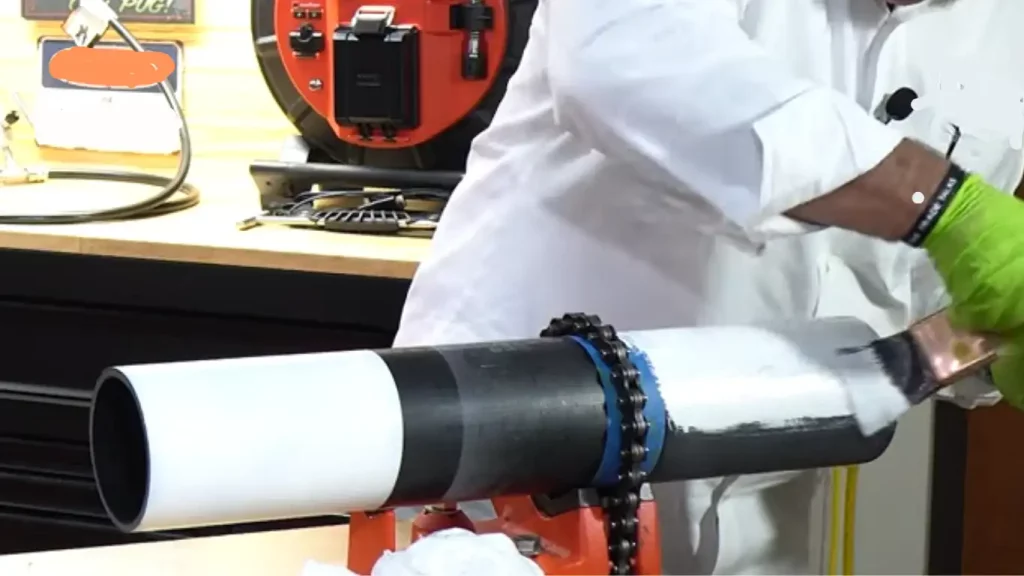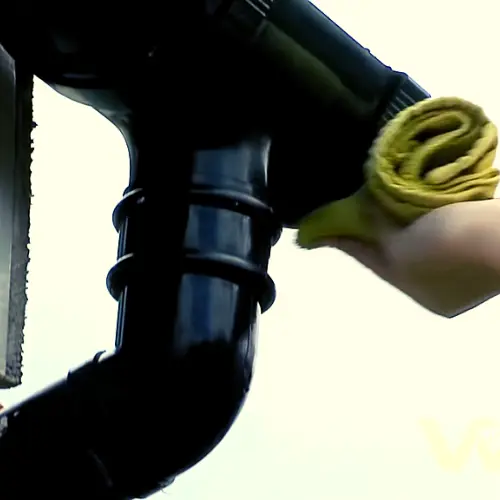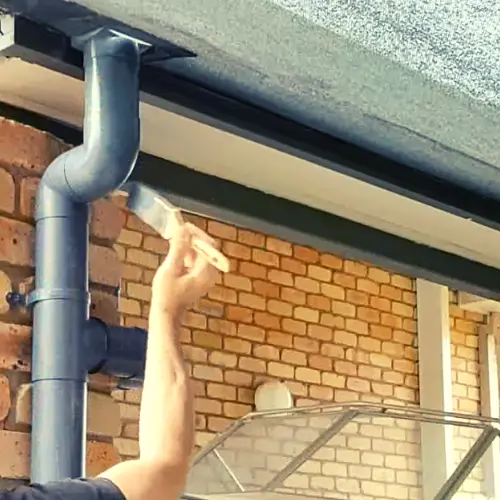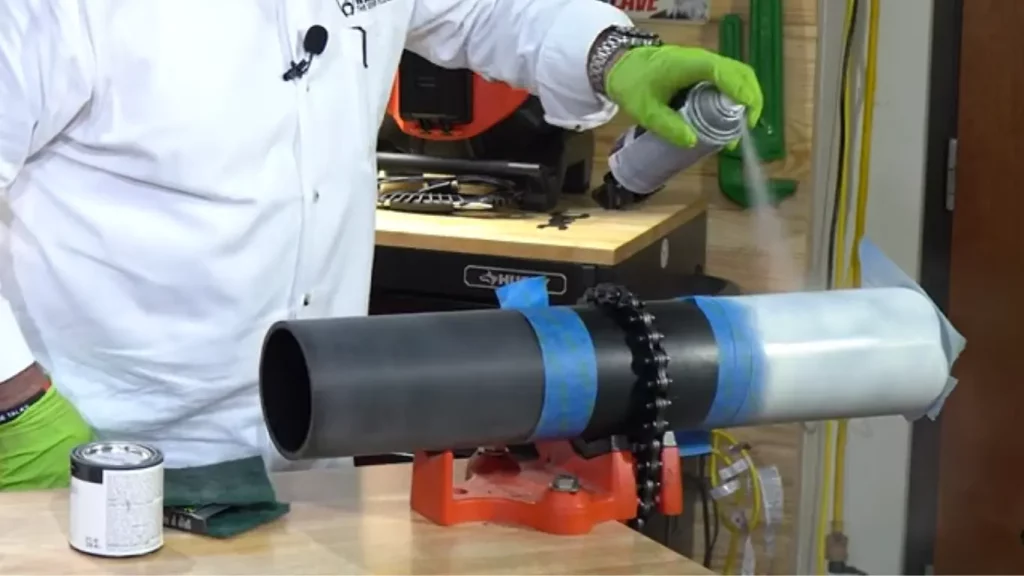Black plumbing plastic tubes are a common fixture in residential and commercial plumbing applications. They are usually joined together using fittings and clamps. They are typically used for drains, waste pipes, and vent pipes.
This black color helps to absorb heat, which can be beneficial in colder climates. But many homeowners and businesses wonder if paint can be applied to these pipes.
So, can you paint black plumbing plastic tubes? Throughout this article, we will take a closer look at the question at hand and also answer questions related to this so that you can make an informed decision and increase the decor of your home. So, let’s get to it.

Black Plumbing Plastic Tubes: Can They be Painted?
The quick answer is yes, you can paint black plumbing plastic tubes. These plastic pipes are made of high-density polyethylene (HDPE), which is a durable, tough material. You may want to paint black plumbing plastic tubes because they are visible in the home and can be an eyesore.
Also, the plastic may be discolored or scratched, making it difficult to match the rest of the home’s decor. The good news is there are two kinds of paint you can use on black plastic pipes: enamel oil-based paint and latex paint.
Enamel Oil-based paint is more durable and will last longer, but it’s also more difficult to apply and can be messy. Latex paint is less durable but easier to apply and clean up.
Reasons to Paint Black Plumbing Plastic Tubes
1. Aesthetic Appeal:
One of the primary reasons to paint black plumbing plastic pipes is for aesthetic appeal. Black pipes can be an attractive addition to any home, and they can help to complement the overall design of your space. Additionally, black pipes can help to make a small bathroom appear larger.
2. Increased Durability:
Another reason to paint black plumbing plastic pipes is to provide increased durability. Paint can help to protect the pipes from damage caused by UV rays, weathering, and other environmental factors. Additionally, paint can help to prevent the pipes from rusting or corroding over time.
3. Easy to Clean:
Black plumbing plastic pipes that have been painted are also easy to clean. Dirt and grime will not adhere as easily to the surface of the pipes, and any build-up can be easily removed with a damp cloth or sponge.
4. Hide Imperfections:
If your black plumbing plastic pipes are not perfectly smooth or have any imperfections, painting them can help to hide these flaws. Once the pipes are painted, any bumps, dents, or scratches will be less visible.
5. Cost-Effective Solution:
Painting them is also a cost-effective solution when compared to replacing the pipes entirely. If you are looking for a way to improve the appearance of your home without breaking the bank, painting the pipes is a great option.
6. Quick and Easy Process:
Painting black plastic plumbing pipes is a quick and easy process that does not require any special skills or knowledge. In most cases, all you need is a can of paint and a paintbrush. If you are not comfortable painting the pipes yourself, you can always hire a professional to do it for you.
7. Can Be Done Yourself:
Lastly, painting these pipes is a project that can easily be done by most people without any professional assistance.
What Procedures Should be Followed to Paint Black Plumbing Plastic Tubes?
There are a few things you need to do in order to ensure that the paint will adhere properly and that the finished product will look good. Here’s what you need to do:
1. Choose the right type of paint:
Latex-based paints are a good option because they’re durable and won’t chip or peel easily. In contrast, if you’re looking for a more decorative finish, you can use acrylic-based paints. Just make sure that whatever type of paint you choose is designed for use on plastic surfaces.
2. Clean the surface thoroughly:
Before you start painting, you need to make sure that the surface is clean and free of any dirt, grime, or grease. The best way to do this is to wipe down the surface with a damp cloth or paper towel and then let it air dry completely. If there are any stubborn spots, you can use a mild detergent or rubbing alcohol to remove them.

3. Sand the Surface or Do Chemical Etching:
Paints have difficulty adhering to plastic surfaces, especially smooth ones. The adhesion process is primarily mechanical and/or chemical. Smooth surfaces lack the ridges or other features that would allow for mechanical attachment, while plastics generally have few, if any, groups that would give rise to the chemical attachment.
One way to increase the adhesion of paint to plastic is to roughen the surface of the plastic. This can be done by sanding it down or using a chemical etching process.
4. Apply a primer:
Once the surface is clean and dry, you’ll need to apply a primer before painting. This step is important because it will help the paint adhere better to the plastic surface.
When choosing a primer, look for one that’s designed for use on plastic surfaces. Apply the primer according to the manufacturer’s instructions and let it dry completely before moving on to the next step.
5. Paint in thin coats:
When you’re ready to start painting, be sure to work in thin coats so that the paint doesn’t run or drip. Apply each coat evenly and let it dry completely before adding another layer of paint.
Depending on the type of paint you’re using, you may need to apply multiple coats in order to achieve the desired results.

Do All Kinds of Paint Stay On Black Plumbing Plastic Tubes?
The simple answer is no. Three main types of paint are frequently applied to black plumbing plastic tubes: oil-based paint, water-based paint, and lacquer. Oil-based paint is the most durable option, but it can be difficult to apply evenly and can take longer to dry.
Water-based paint is easier to apply and dries more quickly, but it isn’t as durable as oil-based paint. Lacquer is the most difficult to apply but provides the most protection against chipping and wear. All three types of paint will stay on black plumbing plastic tubes if applied correctly.
Is it Possible to Spray Paint Black Plumbing Plastic Tubes?
While it is possible to spray paint black plumbing plastic tubes, it is important to take certain precautions before doing so. To begin with, the surface of the tube must be thoroughly cleaned and sanded to provide a smooth surface for the paint to adhere to. Next, a primer designed for use on plastic should be applied.
Once the primer has dried, the final step is to apply a coat or two of paint, allowing each coat to dry completely before applying the next. When following these steps, it is possible to achieve a professional-looking paint job on black plumbing plastic tubes.

Do You Need Prime Black Plumbing Plastic Tubes to Paint it?
Before painting a black plumbing plastic tube, it is important to prime it first. Priming the tubing will help the paint to adhere better and will also help to prevent the paint from chipping or flaking off over time.
There are a few different types of primers that can be used on them, so make sure you choose one that is designed for use with this type of material. Once the primer has been applied, the tube can then be painted as desired.
Can Tempera Paint Be Used to Paint on Black Plumbing Plastic Tubes?
Tempera paint is a type of water-based paint that is made from a pigment and a binding agent, such as gum Arabic. It has been used for centuries to create artworks, and it is still widely used by artists today. You can use tempera paint on wood, paper, paperboard, and also on cardboard.
So, you should not use tempera paint to paint these tubes. The reason for this is that tempera paint is not very resistant to fading or chipping. Also, if the tempera paint comes into contact with water, it will quickly wash away. For these reasons, it is best to use acrylic or latex paint when painting on black plumbing plastic tubes.
What Are the Risks of Painting Black Plumbing Plastic Tubes?
Although painting black plumbing plastic tubes may seem like an easy way to improve the aesthetics of your home, there are some risks to consider before you start.
- Paint can chip and flake off, which can clog pipes and cause water damage.
- Paint can react with the chemicals in plumbing cleaners and create harmful fumes.
- Paint can make it more difficult to spot leaks, which can lead to extensive damage if left unrepaired.
- Black plastic is often treated with chemicals that can be harmful if inhaled or ingested.
Overall, painting black plastic plumbing tubes should be cautiously approached and only done if you are prepared to accept the risks.
Is There a Standard Drying Time for Paints Used on Black PVC Tubes?
The drying time for paint on a black PVC tube will depend on various factors, such as the type of paint used, the thickness of the paint layer, the humidity and temperature of the environment, and whether a primer was used. For example, oil-based paints typically take longer to dry than latex-based paints.
In general, though, you can expect the paint to be dry to the touch within 1-2 hours. But, it is essential to wait 24 hours before handling the painted item to allow the paint to cure fully. Once cured, the paint will be more resistant to scratches and marks.
Final Words:
Hopefully, by now, it is clear to you that you can paint black plastic plumbing tubes. It is advisable to use a primer before painting black plumbing plastic tubes to ensure better paint adhesion. Once the primer is dry, you can then proceed to paint the tubes with your desired color.
Be sure to use a paint that is specifically designed for use on plastic surfaces. When applying the paint, be sure to use even strokes and allow the paint to dry completely between coats. With the right type of paint, you can transform any black plumbing plastic tube into a work of art. Happy painting!

S. Pushon is a paint expert, self-taught artist, and currently working as an adviser in the paint industry as a Quality Improvement and Development Assistant.
An artist by heart, he draws remarkable art pieces and as a professional paint industry individual, he seeks the insight and shares with enthusiasts. Read more…

